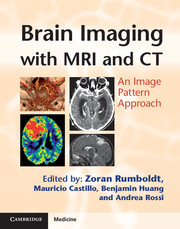Book contents
- Frontmatter
- Contents
- List of contributors
- List of abbreviations
- Preface
- Section 1 Bilateral Predominantly Symmetric Abnormalities
- Section 2 Sellar, Perisellar and Midline Lesions
- Section 3 Parenchymal Defects or Abnormal Volume
- Section 4 Abnormalities Without Significant Mass Effect
- Section 5 Primarily Extra-Axial Focal Space-Occupying Lesions
- Section 6 Primarily Intra-Axial Masses
- Section 7 Intracranial Calcifications
- Index
Preface
Published online by Cambridge University Press: 05 August 2013
- Frontmatter
- Contents
- List of contributors
- List of abbreviations
- Preface
- Section 1 Bilateral Predominantly Symmetric Abnormalities
- Section 2 Sellar, Perisellar and Midline Lesions
- Section 3 Parenchymal Defects or Abnormal Volume
- Section 4 Abnormalities Without Significant Mass Effect
- Section 5 Primarily Extra-Axial Focal Space-Occupying Lesions
- Section 6 Primarily Intra-Axial Masses
- Section 7 Intracranial Calcifications
- Index
Summary
This book was conceived based on the requests and suggestions from radiology residents and neuroradiology fellows (especially once they actually started practicing) and on my own interest in writing a different kind of book. There are already some what similar volumes with a differential diagnosis instead of a textbook format; however, the pattern approach, by which the entities are grouped into categories based solely on the imaging findings, represents a novel concept.
The goal of this work is to be useful in real life clinical practice (as well as the board exams) – it is not intended just for neuroradiologists, but probably even more so for practicing general radiologists, neurologists, neurosurgeons, pediatricians and other physicians. The book starts with the bilateral symmetric and midline lesion patterns, as these are the easiest ones to miss, especially by relatively inexperienced readers.
The design has been standardized with images on the left-hand page and the text on the right, and I am personally responsible for the layouts of well over 1500 pictures. Every attempt has been made to include at least two different patients with each entity, and there are only a few with a single one, while frequently the cases comprise images from three or more individuals. The text is concise and broken down into smaller sections, stressing the distinguishing features, both imaging and clinical, with links to other similar cases under the differential diagnosis section.
- Type
- Chapter
- Information
- Brain Imaging with MRI and CTAn Image Pattern Approach, pp. xv - xviPublisher: Cambridge University PressPrint publication year: 2012

